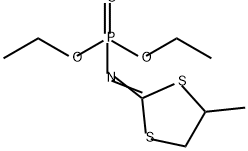| | MEPHOSFOLAN Basic information |
| Product Name: | MEPHOSFOLAN | | Synonyms: | (40-methyl-1,3-dithiolan-2-ylid-ene)phosphoramidicaciddiethylester;2-(diethoxyphosphinylimino)-4-methyl-3-dithiolane;cyclicpropylenep,p-diethylphosphonodithioimidocarbonate;cytrolaneinsecticide;diethyl(4-methyl-1,3-dithiolan-2-ylidene)phosphoroamidate;diethyl-4-methyl-1,3-dithiolan-2-ylidenephosphoramidate;ei47470;ei-47470 | | CAS: | 950-10-7 | | MF: | C8H16NO3PS2 | | MW: | 269.32 | | EINECS: | 213-447-3 | | Product Categories: | | | Mol File: | 950-10-7.mol |  |
| | MEPHOSFOLAN Chemical Properties |
| Boiling point | bp0.001 120° | | density | 1.539 g/cm3 (26℃) | | refractive index | 1.5354 (589.3 nm 26℃) | | storage temp. | APPROX 4°C | | pka | -4.93±0.40(Predicted) | | Merck | 13,5880 | | EPA Substance Registry System | Mephosfolan (950-10-7) |
| | MEPHOSFOLAN Usage And Synthesis |
| Description | Mephosfolan is a yellow to amber liquid. Molecular weight= 269.34;Boiling point=120℃ at 1.0 mmHg. Hazard Identification (based on NFPA-704 M Rating System): Health 4, Flammability 1, Reactivity 0. Moderately soluble in water. | | Chemical Properties | Mephosfolan is a yellow to amber liquid | | Uses | Insecticide, acaricide. | | General Description | Yellow to amber liquid. Works as an insecticide and acaricide. Not registered as a pesticide in the U.S. | | Reactivity Profile | When heated to decomposition, MEPHOSFOLAN emits very toxic fumes of nitrogen oxides, phosphorus oxides and sulfur oxides. Stable at neutral pH. Hydrolyzed by acid or alkali. [EPA, 1998]. Organophosphates, such as MEPHOSFOLAN, are susceptible to formation of highly toxic and flammable phosphine gas in the presence of strong reducing agents such as hydrides. Partial oxidation by oxidizing agents may result in the release of toxic phosphorus oxides. | | Health Hazard | MEPHOSFOLAN is highly toxic if swallowed or absorbed through the skin. | | Fire Hazard | When heated to decomposition, MEPHOSFOLAN emits very toxic fumes of nitrogen oxides, phosphorus oxides and sulfur oxides. Stable at neutral pH. Hydrolyzed by acid or alkali. | | Safety Profile | Poison by ingestion and
skin contact. When heated to decomposition it emits very toxic fumes of NOx, POx, and
sox. | | Potential Exposure | A potential danger to those involved
in the production, formulation, and application of this
insecticide and acaricide. Not currently registered for use in
the US | | First aid | If this chemical gets into the eyes, remove any contact lenses at once and irrigate immediately for at least 15 min, occasionally lifting upper and lower lids. Seek medical attention immediately. If this chemical contacts the skin, remove contaminated clothing and wash immediately with soap and water. Speed in removing material from skin is of extreme importance. Shampoo hair promptly if contaminated. Seek medical attention immediately. If this chemical has been inhaled, remove from exposure, begin rescue breathing (using universal precautions, including resuscitation mask) if breathing has stopped and CPR if heart action has stopped. Transfer promptly to a medical facility. When this chemical has been swallowed, get medical attention. Give large quantities of water and induce vomiting. Do not make an unconscious person vomit. | | storage | Color Code—Blue: Health Hazard/Poison: Store in a secure poison location. Prior to working with this chemical you should be trained on its proper handling and storage. Store in tightly closed containers in a cool, wellventilated area away from strong oxidizers, strong acids. | | Shipping | N3018 Organophosphorus pesticides, liquid,
toxic, Hazard Class: 6.1; Labels: 6.1-Poisonous materials.
UN2810 Toxic liquids, organic, n.o.s., Hazard Class: 6.1;
Labels: 6.1-Poisonous materials, Technical Name Required | | Incompatibilities | Incompatible with oxidizers (chlorates,
nitrates, peroxides, permanganates, perchlorates, chlorine,
bromine, fluorine, etc.); contact may cause fires or explosions. Keep away from alkaline materials, strong bases,
strong acids, oxoacids, epoxides. Similar organic amides
react with azo and diazo compounds, releasing toxic gases.
Contact with reducing agents can release flammable gases.
Amides are very weak bases but they can react as acids,
forming salts. Mixing amides with dehydrating agents
such as such as phosphorus pentoxide or thionyl chloride
generates the corresponding nitrile. | | Waste Disposal | In accordance with 40CFR
165 recommendations for the disposal of pesticides and
pesticide containers. Must be disposed properly by following package label directions or by contacting your local or
federal environmental control agency, or by contacting
your regional EPA office |
| | MEPHOSFOLAN Preparation Products And Raw materials |
|